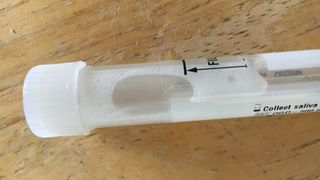
When you purchase through links on our site, we may earn an affiliate commission. Here’s how it works.

The U.S. Food and Drug Administration (FDA) has approved the first at-home saliva collection test for COVID-19, which people could use to sample their own saliva and send it into a lab for results.
Developed by RUCDR Infinite Biologics, a biorepository based at Rutgers University in New Jersey, the test received "amended emergency use authorization" from the FDA late on May 7, according to a statement from the university. In April, the lab received emergency use authorization for their saliva collection method, which allowed health care workers to begin testing New Jersey residents at select sites throughout the state, The New York Times reported April 29.
Now, the amended authorization will allow people to collect their own saliva at home and avoid potentially risky contact with people at testing sites. The only other at-home coronavirus test on the market requires users to collect samples using a nose swab, The New York Times reported May 7.
"Collecting a saliva sample at home mitigates the risk of exposure needed to travel to a facility or drive-through and is less invasive and more comfortable and reliable than sticking a swab up your nose or down your throat," Andrew Brooks, chief operating officer and director of technology development at RUCDR, said in the statement.
When compared with swab tests for the coronavirus, which rely on samples collected from the nose and throat, the saliva-based test generated fewer false-negative results in severely infected people, meaning it was more reliable at confirming an active infection, according to the Times report published April 29. The rate at which COVID-19 swab tests deliver false-negative results has raised concerns among health care professionals, Live Science previously reported; saliva-based tests could provide consistency where these other tests have faltered.
In the same comparison, the saliva tests garnered no false-positive results, either.
Get the world’s most fascinating discoveries delivered straight to your inbox.
By submitting your information you agree to the Terms & Conditions and Privacy Policy and are aged 16 or over.
During collection, a person would spit into a container holding a preservative liquid developed by the medical equipment manufacturer Spectrum Solutions, according to the Rutgers statement. The exact recipe for the solution remains a secret, but the ingredients are readily available, the Times reported. Like swab tests, however, the saliva-based test relies on PCR machines to process sampled genetic material; specific chemical reagents are needed to run the machines and could present supply chain problems, Angela Rasmussen, a virologist at Columbia University, told the Times.
That said, the at-home saliva test could address "many critical issues associated with large-scale screening that is required to get people back to their normal daily lives," Brooks said. During the month of April, the Rutgers lab processed nearly 90,000 tests conducted at their in-person testing sites and planned to increase their testing capacity to 30,000 tests a day, Brooks told the Times. At the time, test results could be delivered back to patients within 72 hours, but the turnaround time could be cut down to only a few hours with all the right infrastructure in place, according to the Times report.
Now that people can collect their own samples remotely, the Rutgers lab could feasibly process "tens of thousands of samples daily," according to the statement.
For a limited time, you can take out a digital subscription to any of our best-selling science magazines for just $2.38 per month, or 45% off the standard price for the first three months.